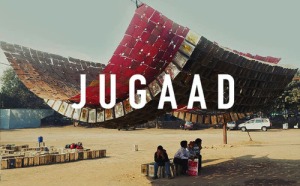Jugaad is Hindi for “an improvised solution bom from ingenuity and cleverness” (De Vita, 2012: 21). Sometimes referred to as “frugal innovation,” jugaad is a way to think about most of the world’s experience with and approach to infrastructure, according to Vyjajanthia Rao (2015) in an essay featured in the edited book Infrastructural Lives. Defined as “innovative, improvisational urban practices and the objects they produce as temporary “fixes” or solutions to systematic problems,” Rao (2015: 54) notes that while the dominant “decay discourse” overwhelmingly depicts infrastructure as dilapidated and falling apart, this dominant discourse provides an almost too perfect foil for the conviviality and colorfulness with which jugaad is often celebrated with.
ETHICS OF CELEBRATING JUGAAD
Celebrating jugaad, however, is not an innocent act, especially from the “outside looking in.”
If we celebrate jugaad, then we run the risk of assimilating it into the “sphere of capitalist entrepreneurship,” Rao claims, which can be neatly encapsulated in a new book Jugaad Innovation : Think Frugal, Be Flexible, Generate Breakthrough Growth by Navi Radjou, Jaideep Prabhu and Simone Ahuja, authors known for their blogging at the Harvard Business Review such as “Think like an Indian Entrepreneur.” Hence, the boat seems to have sailed. Alternatively, celebrating jugaad might lead to no change in the systems, as though these innovative adjustments to circumstances outside of anybody’s immediate control are themselves working solutions or, far worse, part of visual tapestry tourists have come to expect in certain areas, but “even more perniciously,” Rao (2015: 54) writes, such celebration “turns the conditions for contemplating necessary ethical problems into permanently speculative and provisional ones.” Though the urban ethics are far, far different, the theme sort of reminds me of a recent documentary about “street art” going mainstream called Exit through the gift shop.
http://www.dailymotion.com/video/xtua7w_exit-through-the-gift-shop_lifestyle
IS JUGAAD JUST A “WORKAROUND,” AS WE KNOW IT IN THE WEST
I was tempted, at first, to see jugaad as “workaround“ — an important topic for infrastructure studies — just in a non-Western language. The temptation to impose categories is powerful; the temptation to explicitly not extract terminology from its originating context is at least as powerful, especially to conscientious thinkers. However, the passage on jugaad on Wikipedia gives me pause — maybe even has me thinking otherwise — here’s why: a citation-less statement indicates that while jugaad is about survival in some areas of the East and Global South, the workaround (or a “hack”) is more of an artistic statement in some areas of the West and Global North (I interpolated the regional issues there, I know they are clumsy). This begs the obvious question “when is a workaround a hack and when it is not?” but we could add a third dimension, namely, the jugaad and now ask about how individuals approach infrastructure: workaround, hack, or jugaad?
CITATIONS
De Vita, Emma. Jugaad. Third Sector 709 (May 29, 2012): 21.
Radjou, Navi, Prabhu, Jaideep, and Ahuja, Simone. Jugaad Innovation: Think Frugal, Be Flexible, Generate Breakthrough Growth (2012).
Rao, Vyjajanthia. Infra-City in Infrastructural Lives edited by Graham and McFarlane (2015).

Pingback: Infrastructural Lives, Reviewed | Installing (Social) Order
Pingback: Infrastructure Toolbox | Installing (Social) Order
Pingback: Jugaad, Siqizai, Bricolage | Installing (Social) Order
Pingback: On Revanchist Policy and Water Infrastructure | Installing (Social) Order
Pingback: Simone on Infrastructure in Postcolonial Urban Environments | Installing (Social) Order
we’ll see, tricky to coordinate across time zones and all but i’m hopeful
http://www.theguardian.com/global-development/audio/2015/jun/23/sustainable-development-goals-financing-development-addis-ethiopia
LikeLike
I was just joking anyways — that said, the project you were referencing has lots and lots of potential…
On Mon, Jun 22, 2015 at 9:48 PM, Installing (Social) Order wrote:
>
LikeLike
ah no comment-threads are always messy and with my malfunctioning memory i’m sure i’ve asked you about things (or sent you things) more than once
LikeLike
great thanks
LikeLike
hahaahah — I am a self-centered maniac! jk
On Mon, Jun 22, 2015 at 11:21 AM, Installing (Social) Order wrote:
>
LikeLike
I just emailed to be added to the list, too!
LikeLike
yes thanks, was extending an invite to yer guest
LikeLike
Thanks. I haven’t studied jugaad explicitly, but I am really interested in how materials, practices, data, infrastructure, etc. are made to work together. So the notion of jugaad has been really helpful.
LikeLike
Check the last round of e-mails — I’m already in!
On Mon, Jun 22, 2015 at 10:26 AM, Installing (Social) Order wrote:
>
LikeLike
thanks for the resources, be interested in yer help/input with:
LikeLike
yes that’s perfect, and to the point of what’s the difference between tinkering/bricolage and the whole entrepreneurial-startup-trip?
can’t just be intentions or even internal organization but must somehow include the surround/infrastructures of law, economics, financing, etc.
how not to end up being another gear in (or masking/humanizing face of) the machine if you will?
LikeLike
By the way, as soon as that sound clip concludes THE LISTENER GETS A COMMERCIAL FOR CORNELL’S MBA PROGRAM!!!
LikeLike
Selling out — that had not occurred to me about this topic (even though it was me who obviously added the street art commentary … possibly how ingrained this new culture is )
LikeLike
Very cool JB — thanks for passing along. I’ve got the papers on my must read list. Out of curiosity, is that (jugaad) a topic you study too?
LikeLike
Thank you for this post. It’s great to hear about these new sources as well as the problems with celebrating–or only celebrating–jugaad.
On jugaad, I’ve also used two articles that are available via academia.edu. They’re by a former colleague. The first deals with jugaad as a commons, and the second with jugaad in the lab:
Sekhsaria, P. “Jugaad as a Conceptual and Materials Commons.” Common Voices, no. 8 (2011): 21–23.
Sekhsaria, P. “The making of an indigenous Scanning Tunneling Microscope and Technological Jugaad as a culture of innovation in India”
Thanks,
Jess
LikeLiked by 1 person
https://soundcloud.com/brian-lehrer-show/douglas-rushkoff-on-how-kids
LikeLike